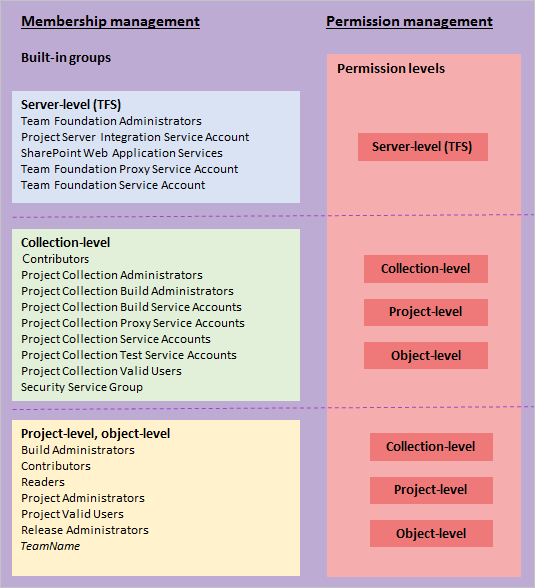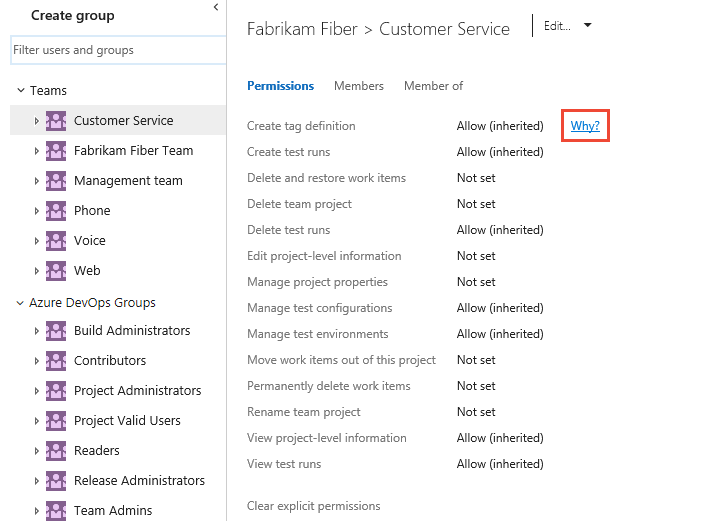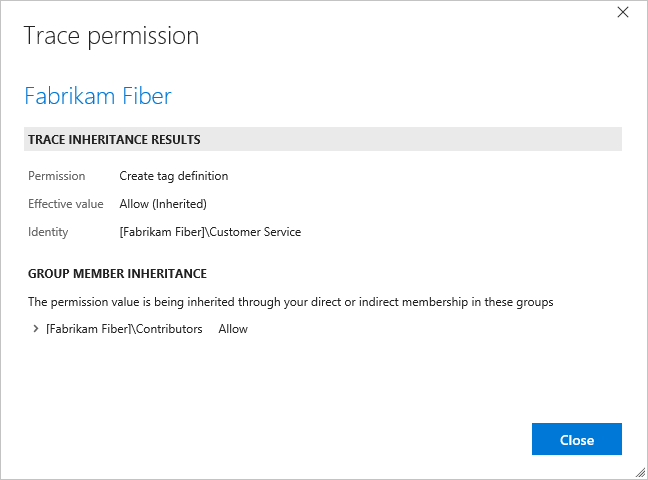Get started with permissions, access, and security groups
TFS 2017 | TFS 2015 | TFS 2013
When it comes to accessing an Azure DevOps feature, it's helpful to understand the following key concepts.
-
- All users added to Azure DevOps are added to one or more default security groups.
- Security groups are assigned permissions, which either allow or deny access to a feature or task.
- Members of a security group inherit the permissions assigned to the group.
- Permissions are defined at different levels: organization/collection, project, or object.
- Other permissions are managed through role-based assignments, such as team administrator, extension management, and various pipeline resource roles.
- Administrators can define custom security groups to manage permissions for different functional areas.
-
- All users added to Azure DevOps are assigned to an access level, which grants or restricts access to select web portal features.
- There are three main access levels: Stakeholder, Basic, and Basic + Test Plans.
- Stakeholder access provides free access to an unlimited number of users to a limited set of features. For details, see Stakeholder access quick reference.
For example, most Azure DevOps users are added to the Contributors security group and granted Basic access level. The Contributors group provides read and write access to repositories, work tracking, pipelines, and more. Basic access provides access to all features and tasks for using Azure Boards, Azure Repos, Azure Pipelines, and Azure Artifacts. Users who require access to manage Azure Test Plans need to be granted Basic + Test Plans or Advanced access.
Administrators should be added to the Project Collection Administrators or Project Administrators group. Administrators manage security groups and permissions from the web portal, primarily from Project settings. Contributors manage permissions for objects they create from the web portal as well.
For an overview of default permissions, see Default permissions quick reference.
Security groups and membership
With the creation of an organization, collection, or project—Azure DevOps creates a set of default security groups, which are automatically assigned default permissions. Additional security groups are defined with the following actions:
- When you create custom security groups at the following levels:
- Project-level
- Organization- or collection-level
- Server-level (on-premises only)
- When you add a team, a team security group is created
Tip
You can't create an object-level security group, but you can assign a custom group to an object-level and assign permissions to that level. To learn more about object-level permissions, see Set object-level permissions.
Default security groups
The following security groups are defined by default for each project and project collection. You typically add users or groups to the Readers, Contributors, or Project Administrators groups.
Note
The following list indicates the latest groups defined for TFS 2017 and later versions. For earlier versions of Azure DevOps, the list may differ. Only add service accounts to Azure DevOps service account groups. To understand valid user groups, see Valid user groups later in this article.
| Project level | Collection level |
|---|---|
| - Build Administrators - Contributors - Project Administrators - Project Valid Users - Readers - Release Administrators - TeamName Team |
- Project Collection Administrators - Project Collection Build Administrators - Project Collection Build Service Accounts - Project Collection Proxy Service Accounts - Project Collection Service Accounts - Project Collection Test Service Accounts - Project Collection Valid Users - Security Service Group |
Tip
For users tasked with managing project-level features —such as, teams, area and iteration paths, repositories, service hooks, and service end points—add them to the Project Administrators group. For users tasked with managing organization or collection-level features —such as, projects, policies, processes, retention policies, agent and deployment pools, and extensions—add them to the Project Collection Administrators group. To learn more, see About user, team, project, and organization-level settings.
For a description of each group and each permission, see Permissions and groups reference, Groups.
Membership, permission, and access level management
Azure DevOps controls access through these three inter-connected functional areas:
Membership management supports adding individual user accounts and groups to default security groups. Each default group is associated with a set of default permissions. All users added to any security group are added to the Valid Users group. A valid user is someone who can connect to a project, collection, or organization.
Permission management controls access to specific functional tasks at different levels of the system. Object-level permissions set permissions on a file, folder, build pipeline, or a shared query. Permission settings correspond to Allow, Deny, Inherited allow, Inherited deny, and Not set. To learn more about inheritance, see Permission inheritance and security groups later in this article.
Access level management controls access to web portal features. Based on what has been purchased for a user, administrators set the user's access level to Stakeholder, Basic, Basic + Test, or Visual Studio Enterprise (previously Advanced).
Each functional area uses security groups to simplify management across the deployment. You add users and groups through the web administration context. Permissions are automatically set based on the security group that you add users to, or based on the object, project, collection, or server level to which you add groups.
Security group members can be a combination of users, other groups, and Active Directory groups or a Workgroup.
You can create local groups or Active Directory (AD) groups to manage your users.
Active Directory and Azure Active Directory security groups
You can populate security groups by adding individual users. However, for ease of management, it's easier if you populate these groups by using Azure Active Directory (Azure AD) for Azure DevOps Services and Active Directory (AD) or Windows user groups for Azure DevOps Server. This method enables you to manage group membership and permissions more efficiently across multiple computers.
If you only have to manage a small set of users, then you can skip this step. However, if you foresee that your organization may grow, you may want to set up AD or Azure AD. Also, if you plan on paying for extra services, you'll need to set up Azure AD for use with Azure DevOps to support billing.
Note
Without Azure AD, all Azure DevOps users must sign in using Microsoft accounts, and you must manage account access by individual user accounts. Even if you manage account access using Microsoft accounts, you need to set up an Azure subscription in order to manage billing.
To set up Active Directory for use with Azure DevOps Server, see the following articles:
- Install Active Directory Domain Services (Level 100)
- Active Directory Domain Services Getting Started.
Typically, you should install Active Directory prior to installing Azure DevOps Server.
Valid user groups
When you add accounts of users directly to a security group, they are automatically added to one of the valid user groups.
- Server\Team Foundation Valid Users: All members added to server-level groups.
- ProjectCollectionName\Project Collection Valid Users: All members added to collection-level groups.
- ProjectName\Project Valid Users: All members added to project-level groups.
The default permissions assigned to these groups are primarily limited to read access, such as View build resources, View project-level information, and View collection-level information.
This means that all users that you add to one project can view the objects in other projects within a collection. If you need to restrict view access, then you can set restrictions through the area path node.
If you remove or deny the View instance-level information permission for one of the valid users groups,
no members of the group are able to access the project, collection, or deployment, depending on the group you set.
Access levels
Access levels control what features are visible to users in the web portal, and are dependent on user licenses; permissions control a user's ability to connect to Azure DevOps and use features across Azure DevOps. If you're trying to give someone access to Agile portfolio management or test case management features, you'll want to change access levels, not permissions.
Setting the access level for users or groups doesn't provide them access to a project or the web portal. Only users or groups added to a team or security group can connect to a project and the web portal. Make sure your users have both the permissions and the access level they need. You do this by making sure they're added to the project or a team.
Permissions
As shown in the following image, security groups defined at the project and collection-level can be assigned to permissions assigned at the object, project, and collection level. You can only define server-level security groups to server-level permissions.

For a description of each default security group, see Security groups, service accounts, and permissions.
Permission states
There are five possible assignments made to a permission. They grant or restrict access as indicated.
- User or group has permissions to perform a task:
- Allow
- Inherited allow
- User or group doesn't have permission to perform a task:
- Deny
- Inherited deny
- Not set
Here's what you need to know about permission settings:
Allow or Deny explicitly grants or restricts users from performing specific tasks, and are usually inherited from group membership.
Not set implicitly denies users the ability to perform tasks that require that permission, but allows membership in a group that does have that permission set to take precedence, also known as Allow (inherited) or Inherited allow and Deny (inherited) or Inherited deny.
For most groups and almost all permissions, Deny overrides Allow. If a user belongs to two groups, and one of them has a specific permission set to Deny, that user is not able to perform tasks that require that permission even if they belong to a group that has that permission set to Allow.
In some cases, members of the Project Collection Administrators or Team Foundation Administrators groups may always get the permission even if they are denied that permission in a different group. In other cases such as work item deletion or pipelines, being a member of project collection administrators does not bypass Deny permissions set elsewhere.
Changing a permission for a group changes that permission for all users who are members of that group. In other words, depending on the size of the group, you might affect the ability of hundreds of users to do their jobs by changing just one permission. So make sure you understand the impact before you make a change.
Permission inheritance and security groups
Some permissions are managed through a hierarchy. Within this hierarchy, permissions can be inherited from the parent or overridden. Security groups assign a set of permissions to those members of the group. For example, members of the Contributors group or Project Administrators group are assigned the permissions that are set as Allowed to those groups.
If a permission isn't directly allowed or denied for a user, then it may be inherited in two ways.
Users inherit permissions from the groups to which they belong. When a permission is allowed for a user directly or through membership in a group that has that permission, and it is denied, either directly or through group membership, the permission is denied.
Members of Project Collection Administrators or Team Foundation Administrators retain most allowed permissions, even if they belong to other groups that deny those permissions. Work item operation permissions are the exception to this rule.
Object-level permissions that are assigned for nodes of a hierarchy - areas, iterations, version control folders, work item query folders - are inherited down the hierarchy. That is, a user's permissions that are set at
area-1are inherited byarea-1/sub-area-1, if the same permission is not explicitly allowed or denied forarea-1/sub-area-1. If a permission is set explicitly for an object, likearea-1/sub-area-1, then the parent node is not inherited, regardless of whether it is denied or allowed. If it's not set, then the permissions for that node are inherited from the closest ancestor that has the permission explicitly set. Lastly, in the object hierarchy, specificity trumps inheritance. For example, a user whose permissions are explicitly set to Deny on 'area-1' but are also explicitly set to Allow for 'area-1/sub-area-1' will ultimately receive an Allow on 'area-1/sub-area-1'.
To understand why a permission is inherited, you can pause over a permission setting, and then choose Why? To open a Security page, see View permissions.
The preview user interface for the Project Permissions Settings Page isn't available for Azure DevOps Server 2020 and earlier versions.
When assigning permissions
Do:
- Use Azure Active Directory, Active Directory, or Windows security groups when managing lots of users.
- When adding teams, consider what permissions you want to assign to team leads, scrum masters, and other team members who may need to create and modify area paths, iteration paths, and queries.
- When adding many teams, consider creating a Team Administrators custom group where you allocate a subset of the permissions available to Project Administrators.
- Consider granting the work item query folders Contribute permission to users or groups that require the ability to create and share work item queries for the project.
Don't:
- Don't add users to multiple security groups which contain different permission levels. In certain cases, a Deny permission level may override an Allow permission level.
- Don't change the default assignments made to the valid users groups. If you remove or set the View instance-level information permission to Deny for one of the Valid Users groups, no users in the group are able to access the project, collection, or deployment, depending on the group you set.
- Don't assign permissions that are noted as 'Assign only to service accounts' to user accounts.
Role-based permissions
With Role-based permissions, you assign user accounts or security groups to a role, with each role assigned one or more permissions. Here are the primary roles and links to learn more.
Artifact or package feed security roles: Roles support various permission levels to edit and manage package feeds.
Marketplace extension Manager role: Members of the Manager role can install extensions and respond to requests for extensions to be installed.
Pipeline security roles: Several roles are used to manage library resources, project-level and collection-level pipeline resources.
Team administrator role Team administrators are able to manage all team tools.
Note
Members of the Project Administrators or Project Collection Administrators groups can manage all team tools for all teams.
Preview features
Access to select, new features are controlled by feature flags. Periodically, Azure DevOps Services introduces new features by placing them behind a feature flag. Preview features can be enabled or disabled by project members or organization owners. To learn more, see Manage or enable features.
Next steps
Related articles
- Troubleshoot access and permission issuesAbout security, authentication, and authorization
- Active Directory Domain Services Overview
- AD DS Getting Started
- Permissions and groups reference
- Security and permission management tools
- Add users to a team or a project
- Add and manage security groups
- Manage tokens, namespaces, permissions
- Permissions and groups reference
- Security and permission management tools

